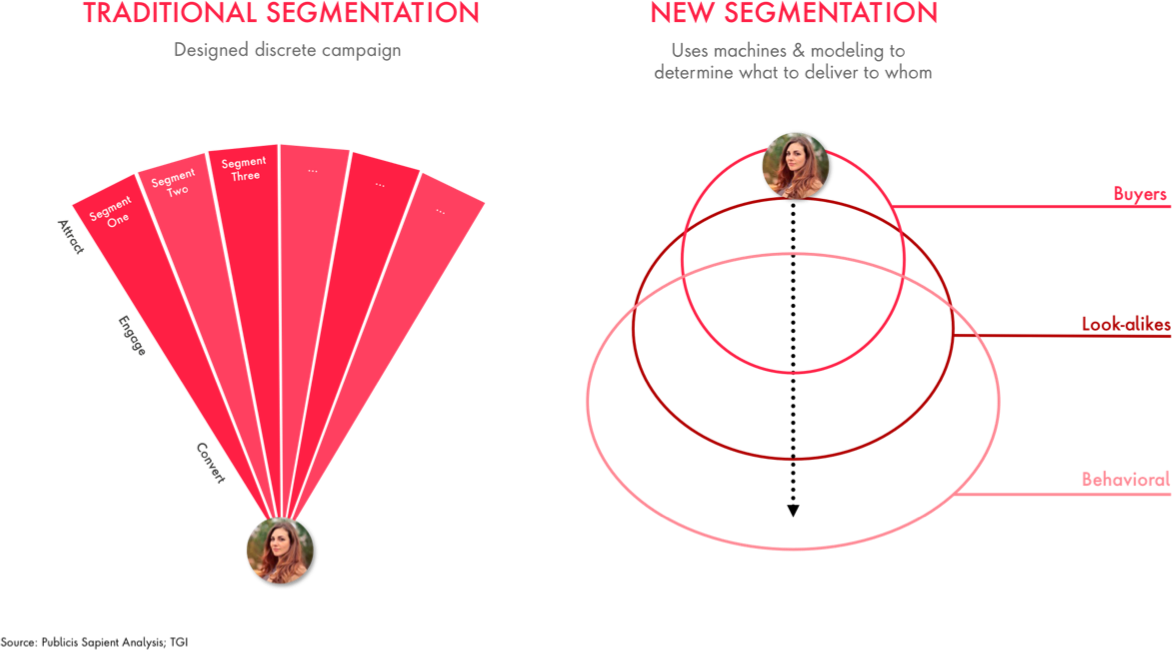What issue can we solve for you?
Type in your prompt above or try one of these suggestions
Suggested Prompt


AI and machine learning give banks the power to better understand banking patterns in the digital world and more efficiently target their most likely future customers.
Customer segmentation is the process by which marketers seek deeper understanding of their existing customer base. It’s also the fundamental – and perhaps most important – way marketers can put all their customer data to work in service of achieving growth objectives. Practically speaking, it’s how banks can go from just having rich customer profiles to delivering personalized offers and experiences. That’s why customer segmentation is important for banks.
But most banks struggle to find the right balance of precision in customer segmentation: go too broad and you lose relevance and risk making the wrong offer to the wrong person at the wrong time; aim too narrow and it becomes too difficult to scale. To be fair, this is a longstanding challenge and might be a never-ending journey. After all, until we reach the state where every marketing message and promotional offer is 100%-personalized, customer segmentation can always be just a little more precise.
Banks are thinking bigger on customer segmentation
In the age of hyper-personalization, banks are both re-thinking customer segmentation and expanding its parameters. Certainly, most banks can go deeper by understanding, for example, not just which products customers have, but also their lifetime value. Further, banks can seek to know how customers behave at each phase of the customer journey and their unique banking patterns in the digital world.
But the end goal is not simply to categorize or tier existing customers by value or other useful metrics. Rather, banks should seek insights and intelligence to expand the addressable market beyond the existing customer base by identifying where demand most likely already exists. Then they can use customer segmentation to transform the banking experience.
Reversing the funnel: Customer segmentation with AI and machine learning
But whatever we call it, banks that use artificial intelligence (AI) and machine learning will gain a big advantage. Because effective segmentation is a function of the amount and quality of data available, AI and machine learning give banks the firepower they need to process and analyze massive amounts of data. AI-based tools can crunch huge quantities of data (e.g., first-party data) and identify anomalies and patterns within raw behavioral data that indicate propensity to buy.
In that sense, it allows marketers to reverse the traditional marketing funnel based on the ability to find lookalike customers. Instead of sharing one message with as many people as possible in an attempt to generate demand, companies can identify where demand already exists by discovering non-customers who, through patterns of behavior, demonstrate a likelihood to buy.
That means banks can tailor messages and offers to smaller sets of customers, rather than starting with one-to-all or one-to-many messages at the top of the funnel. And the more and better the data AI tools can analyze, the more and better insights they will generate – an important consideration given the pending loss of third-party cookies.
AI makes the identification of such lookalike consumers much more efficient and accurate. Lookalikes – an increasingly valuable commodity in the eyes of marketers – are those individuals who demonstrate behaviors similar to existing customers and are therefore considered the easiest (and most affordable) to acquire as actual customers.
The benefits of AI and machine learning segmentation
The biggest benefit is scalability. These technologies can make the difference between being able to present timely and relevant offers to 10 people via their preferred channels and doing so for 10 million. Certainly, it drives greater efficiency in traditional segmentation processes and supports greater effectiveness; once segmentation-driven campaigns are launched, AI and machine learning tools can quickly analyze results and suggest more effective tactics for the future.
In a time of tight budgets, marketers should also consider how AI and machine learning tools can help generate higher returns on the large investments most banks have made in cloud platforms and in their own first-party data sets and CRM systems. In fact, the equation for optimal economic results from segmentation might be high-quality first-party data plus rich, timely third-party data plus AI tools and machine learning in the cloud.
How banks can leverage AI in segmentation
It would be an understatement to say that AI and machine learning are game changers for customer segmentation. But, it’s just as important to realize that they won’t produce results entirely by themselves. AI-enabled tools and analytical processes driven by machine learning will perform only as well as they are trained and based on the quality and richness of the data. Fundamentally, that’s why banks must still rely on some proven techniques and human expertise to ensure AI and machine learning deliver optimal results.
-
Work backward from business objectives:
Well-defined use cases help avoid the “tech for tech’s sake” thinking that can limit the success of segmentation and other marketing initiatives. Banks should identify the business objectives (e.g., selling more mortgages in certain geographies or increasing loan penetration in a unique demographic) AI can help them achieve before deployment begins. And the more specific the objective the better.

-

Start with testable hypotheses:
As with defining objectives, AI and machine learning need human inputs before they are unleashed on rich data environments. Analysts can develop and test models tied to commonly held beliefs (e.g., 30 is the best age to make mortgage offers, customers who live within two miles of a branch are the most profitable) with the results leading to more precise segmentation and more informed allocation of marketing budgets.
-
Continually revise and optimize:
The unique power of advanced technology is its ability to get smarter. Once you know more about what triggers customers to buy, you can ask better questions of their channel preferences. This is how you get higher resolution customer profiles over time. Again, the segmentation game is never ultimately won, largely because consumer needs constantly change and businesses are always looking for new and more people to engage as customers. That’s why it should be viewed as a fundamental marketing capability or discipline for banks – and why AI and machine learning are ideal tools for the job.

Banks have long used AI and machine learning to manage fraud risk and prevent revenue loss. The use of AI in the service of smarter customer segmentation at scale is the revenue-generating counterpart. Marketing groups should get just as comfortable as risk management teams in embracing these technologies. We believe it holds the key to success in the age of hyper-personalization.
Related Reading
-
![]()
Pathway to Personalization:
Banks Can Use Cloud to Personalize Everything
By modernizing their cloud computing environments and capabilities, banks can enhance their ability to deliver personalized offers, experiences and campaigns.
-
![]()
Pathway to Personalization:
What Omnichannel Means Today
In consumers’ eyes there’s no such thing as a channel, which is why banks must develop truly Omni-channel capabilities.
-
![]()
Pathway to Personalization:
How to Enhance Data Management for Personalization
More effective data integration and management hold the key to generate actionable customer insights and enhance their personalization capabilities.

Are you data-ready?
Better data integration and management is the key to boosting your personalization capabilities. But are you getting the most from your data?
Check out our Pathway to Personalization and discover how to leverage your data into creating hyper-personalized experiences your customers will love.










